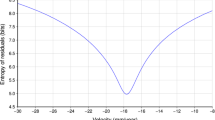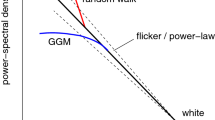Abstract
Some estimates of GPS velocity uncertainties are very low, \(<\)0.1 mm/year with 10 years of data. Yet, residual velocities relative to rigid plate models in nominally stable plate interiors can be an order of magnitude larger. This discrepancy could be caused by underestimating low-frequency time-dependent noise in position time series, such as random walk. We show that traditional estimators, based on individual time series, are insensitive to low-amplitude random walk, yet such noise significantly increases GPS velocity uncertainties. Here, we develop a method for determining representative noise parameters in GPS position time series, by analyzing an entire network simultaneously, which we refer to as the network noise estimator (NNE). We analyze data from the aseismic central-eastern USA, assuming that residual motions relative to North America, corrected for glacial isostatic adjustment (GIA), represent noise. The position time series are decomposed into signal (plate rotation and GIA) and noise components. NNE simultaneously processes multiple stations with a Kalman filter and solves for average noise components for the network by maximum likelihood estimation. Synthetic tests show that NNE correctly estimates even low-level random walk, thus providing better estimates of velocity uncertainties than conventional, single station methods. To test NNE on actual data, we analyze a heterogeneous 15 station GPS network from the central-eastern USA, assuming the noise is a sum of random walk, flicker and white noise. For the horizontal time series, NNE finds higher average random walk than the standard individual station-based method, leading to velocity uncertainties a factor of 2 higher than traditional methods.













Similar content being viewed by others
References
Agnew D (1992) The time-domain behavior of power-law noises. Geophys Res Lett 19(4):333–336. doi:10.1029/91GL02832
Altamimi Z, Collilieux X, Métivier L (2011) ITRF2008: an improved solution of the international terrestrial reference frame. J Geod 85(8):457–473. doi:10.1007/s00190-011-0444-4
Amiri-Simkooei A (2009) Noise in multivariate GPS position time-series. J Geod 83(2):175–187. doi:10.1007/s00190-008-0251-8
Amiri-Simkooei A (2013) On the nature of GPS draconitic year periodic pattern in multivariate position time series. J Geophys Res Solid Earth 118(5):2500–2511
Amiri-Simkooei A, Tiberius C, Teunissen P (2007) Assessment of noise in GPS coordinate time series: methodology and results. J Geophys Res 112(B7). doi:10.1029/2006jb004913
Baldi P, Casula G, Cenni N, Loddo F, Pesci A (2009) GPS-based monitoring of land subsidence in the Po Plain (Northern Italy). Earth Planet Sci Lett 288:204–212. doi:10.1016/j.epsl.2009.09.023
Bennett R, Wernicke B, Niemi N, Friedrich A, Davis J (2003) Contemporary strain rates in the northern Basin and Range province from GPS data. Tectonics 22(2). doi:10.1029/2001tc001355
Bertiger W, Desai SD, Haines B, Harvey N, Moore AW, Owen S, Weiss JP (2010) Single receiver phase ambiguity resolution with GPS data. J Geod 84(5):327–337. doi:10.1007/s00190-010-0371-9
Blewitt G et al (2005) A Stable North American Reference Frame (SNARF): first release. In: The SNARF Working Group, UNAVCO, Stevenson
Bonforte A, Puglisi G (2006) Dynamics of the eastern flank of Mt. Etna volcano (Italy) investigated by a dense GPS network. J Volcanol Geotherm Res 153(3):357–369. doi:10.1016/j.jvolgeores.2005.12.005
Calais E, Stein S (2009) Time-variable deformation in the new Madrid seismic zone. Science 323(5920):1442–1442. doi:10.1126/science.1168122
Calais E, Han J, DeMets C, Nocquet J et al (2006) Deformation of the North American plate interior from a decade of continuous GPS measurements. J Geophys Res 111(B06):402. doi:10.1029/2005jb004253
Davis J, Greenhall C, Stacey P (2005) A Kalman filter clock algorithm for use in the presence of flicker frequency modulation noise. Metrologia 42:1. doi:10.1088/0026-1394/42/1/001
Frankel A, Smalley R, Paul J (2012) Significant motions between GPS sites in the New Madrid Region: implications for seismic hazard. Bull Seismol Soc Am 102(2):479–489. doi:10.1785/0120100219
Gazeaux J, Williams S, King M, Bos M, Dach R, Deo M, Moore AW, Ostini L, Petrie E, Roggero M et al (2013) Detecting offsets in GPS time series: first results from the detection of offsets in GPS experiment. J Geophys Res Solid Earth 118(5):2397–2407. doi:10.1002/jgrb.50152
Hackl M, Malservisi R, Hugentobler U, Wonnacott R (2011) Estimation of velocity uncertainties from GPS time series: examples from the analysis of the South African TrigNet network. J Geophys Res 116(B11):B11404. doi:10.1029/2010jb008142
Hill EM, Davis JL, Tamisiea ME, Lidberg M (2010) Combination of geodetic observations and models for glacial isostatic adjustment fields in Fennoscandia. J Geophys Res 115(B7). doi:10.1029/2009jb006967
Jiang W, Deng L, Li Z, Zhou X, Liu H (2014) Effects on noise properties of GPS time series caused by higher-order ionospheric corrections. Adv Space Res 53(7):1035–1046. doi:10.1016/j.asr.2013.12.037
Johnson H, Agnew D (1995) Monument motion and measurements of crustal velocities. Geophys Res Lett 22(21):2905–2908. doi:10.1029/95gl02661
King MA, Watson CS (2010) Long GPS coordinate time series: multipath and geometry effects. J Geophys Res 115(B4). doi:10.1029/2009jb006543
King MA, Williams S (2009) Apparent stability of GPS monumentation from short-baseline time series. J Geophys Res 114(B10). doi:10.1029/2009jb006319
King MA, Altamimi Z, Boehm J, Bos M, Dach R, Elosegui P, Fund F, Hernández-Pajares M, Lavallee D, Cerveira PJM et al (2010) Improved constraints on models of glacial isostatic adjustment: a review of the contribution of ground-based geodetic observations. Surv Geophys 31(5):465–507. doi:10.1007/s10712-010-9100-4
Kirchner JW (2005) Aliasing in 1/f \(\alpha \) noise spectra: origins, consequences, and remedies. Phys Rev E 71(6). doi:10.1103/physreve.71.066110
Kusche J, Schrama E (2005) Surface mass redistribution inversion from global GPS deformation and Gravity Recovery and Climate Experiment (GRACE) gravity data. J Geophys Res 110(B9). doi:10.1029/2004jb003556
Langbein J (2004) Noise in two-color electronic distance meter measurements revisited. J Geophys Res 109(B04):406. doi:10.1029/2003jb002819
Langbein J (2008) Noise in GPS displacement measurements from Southern California and Southern Nevada. J Geophys Res 113(B05):405. doi:10.1029/2007jb005247
Langbein J (2012) Estimating rate uncertainty with maximum likelihood: differences between power-law and flicker-random-walk models. J Geod 86(9):775–783. doi:10.1007/s00190-012-0556-5
Langbein J, Johnson H (1997) Correlated errors in geodetic time series: implications for time-dependent deformation. J Geophys Res 102(B1):591–603. doi:10.1029/96jb02945
Lidberg M, Johansson JM, Scherneck HG, Davis JL (2007) An improved and extended GPS-derived 3D velocity field of the glacial isostatic adjustment (GIA) in Fennoscandia. J Geod 81(3):213–230. doi:10.1007/s00190-006-0102-4
Liu M, Yang Y, Stein S, Zhu Y, Engeln J (2000) Crustal shortening in the Andes: why do GPS rates differ from geological rates? Geophys Res Lett 27(18):3005–3008. doi:10.1029/2000gl008532
Lü WC, Cheng SG, Yang HS, Liu DP (2008) Application of GPS technology to build a mine-subsidence observation station. J China Univ Min Technol 18(3):377–380. doi:10.1016/s1006-1266(08)60079-6
Mao A, Harrison C, Dixon T (1999) Noise in GPS coordinate time series. J Geophys Res 104(B2):2797–2816. doi:10.1029/1998jb900033
Márquez-Azúa B, DeMets C (2003) Crustal velocity field of Mexico from continuous GPS measurements, 1993 to June 2001: implications for the neotectonics of Mexico. J Geophys Res 108(B9). doi:10.1029/2002jb002241
Merkouriev S, DeMets C (2014) High-resolution estimates of Nubia–North America plate motion: 20 Ma to present. Geophys J Int 196(3):1281–1298. doi:10.1093/gji/ggt463
Murray J, Segall P (2005) Spatiotemporal evolution of a transient slip event on the San Andreas fault near Parkfield, California. J Geophys Res 110(B9). doi:10.1029/2005jb003651
Papanikolaou ID, Roberts GP, Michetti AM (2005) Fault scarps and deformation rates in Lazio-Abruzzo, Central Italy: comparison between geological fault slip-rate and GPS data. Tectonophysics 408(1):147–176. doi:10.1016/j.tecto.2005.05.043
Pritchard M, Simons M, Rosen P, Hensley S, Webb F (2002) Co-seismic slip from the 1995 July 30 Mw = 8.1 Antofagasta, Chile, earthquake as constrained by InSAR and GPS observations. Geophys J Int 150(2):362–376. doi:10.1046/j.1365-246x.2002.01661.x
Psimoulis P, Ghilardi M, Fouache E, Stiros S (2007) Subsidence and evolution of the Thessaloniki plain, Greece, based on historical leveling and GPS data. Eng Geol 90(1):55–70. doi:10.1016/j.enggeo.2006.12.001
Puskas C, Smith R, Meertens C, Chang W (2007) Crustal deformation of the Yellowstone–Snake River Plain volcano-tectonic system: campaign and continuous GPS observations, 1987–2004. J Geophys Res 112(B3). doi:10.1029/2006jb004325
Ray J, Altamimi Z, Collilieux X, van Dam T (2008) Anomalous harmonics in the spectra of GPS position estimates. GPS Solut 12(1):55–64. doi:10.1007/s10291-007-0067-7
Santamaría-Gómez A, Bouin M, Collilieux X, Wöppelmann G (2011) Correlated errors in GPS position time series: implications for velocity estimates. J Geophys Res 116(B1):B01405. doi:10.1029/2010jb007701
Santamaría-Gómez A, Gravelle M, Collilieux X, Guichard M, Míguez BM, Tiphaneau P, Wöppelmann G (2012) Mitigating the effects of vertical land motion in tide gauge records using a state-of-the-art GPS velocity field. Glob Planet Chang 98:6–17. doi:10.1016/j.gloplacha.2012.07.007
Segall P, Davis JL (1997) GPS applications for geodynamics and earthquake studies. Ann Rev Earth Planet Sci 25(1):301–336. doi:10.1146/annurev.earth.25.1.301
Segall P, Matthews M (1997) Time dependent inversion of geodetic data. J Geophys Res 102(B10):22391. doi:10.1029/97jb01795
Serpelloni E, Anzidei M, Baldi P, Casula G, Galvani A (2005) Crustal velocity and strain-rate fields in Italy and surrounding regions: new results from the analysis of permanent and non-permanent GPS networks. Geophys J Int 161(3):861–880. doi:10.1111/j.1365-246x.2005.02618.x
Teferle F, Bingley R, Williams S, Baker T, Dodson A (2006) Using continuous GPS and absolute gravity to separate vertical land movements and changes in sea-level at tide-gauges in the UK. Philos Trans R Soc A Math Phys Eng Sci 364(1841):917–930. doi:10.1098/rsta.2006.1746
Thatcher W (2003) GPS constraints on the kinematics of continental deformation. Int Geol Rev 45(3):191–212. doi:10.2747/0020-6814.45.3.191
Tremayne AR, Harvey AC (1983) Time series models. Economica 50(198):216. doi:10.2307/2554073
Welch O, Bishop G (1995) An introduction to the kalman filter. Technical Report 95-041, University of North Carolina at Chapel Hill
Williams S (2003a) The effect of coloured noise on the uncertainties of rates estimated from geodetic time series. J Geod 76(9):483–494. doi:10.1007/s00190-002-0283-4
Williams S (2003b) Offsets in Global Positioning System time series. J Geophys Res 108(B6). doi:10.1029/2002jb002156
Williams S, Bock Y, Fang P, Jamason P, Nikolaidis R, Prawirodirdjo L, Miller M, Johnson D (2004) Error analysis of continuous GPS position time series. J Geophys Res 109(B3):B03412. doi:10.1029/2003jb002741
Wöppelmann G, Martin Miguez B, Bouin MN, Altamimi Z (2007) Geocentric sea-level trend estimates from GPS analyses at relevant tide gauges world-wide. Glob Planet Chang 57(3):396–406. doi:10.1016/j.gloplacha.2007.02.002
Wyatt FK (1989) Displacement of surface monuments: vertical motion. J Geophys Res 94(B2):1655–1664. doi:10.1029/jb094ib02p01655
Zhang J, Bock Y, Johnson H, Fang P, Williams S, Genrich J, Wdowinski S, Behr J (1997) Southern california permanent GPS geodetic array: error analysis of daily position estimates and site velocities. J Geophys Res 102:18–18. doi:10.1029/97jb01380
Zumberge J, Heflin M, Jefferson D, Watkins M, Webb F (1997) Precise point positioning for the efficient and robust analysis of GPS data from large networks. J Geophys Res 102(B3):5005–5017. doi:10.1029/96jb03860
Acknowledgments
We thank James Davis (Columbia University) for providing the SNARF GIA model. We acknowledge Sang-Ho Yun for writing the notch filter code. We appreciate fruitful discussions and computational help from Andrew Bradley. We thank the reviewer Matt King, editor Simon Williams, and two anonymous reviewers for extremely helpful suggestions. This work was supported by NASA Headquarters under the NASA Earth and Space Science Fellowship Program—Grant 14-EARTH14R-47 and by the USGS Grant G13AP00020.
Author information
Authors and Affiliations
Corresponding author
Rights and permissions
About this article
Cite this article
Dmitrieva, K., Segall, P. & DeMets, C. Network-based estimation of time-dependent noise in GPS position time series. J Geod 89, 591–606 (2015). https://doi.org/10.1007/s00190-015-0801-9
Received:
Accepted:
Published:
Issue Date:
DOI: https://doi.org/10.1007/s00190-015-0801-9




